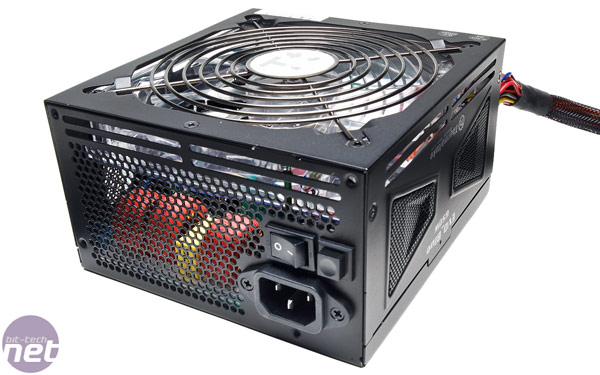600 - 700W PSU Review Round-Up
February 22, 2010 | 09:49
Companies: #akasa #antec #be-quiet #bit-tech #enermax #seasonic #silverstone #tagan #thermaltake #xfx

Enermax ECO80+ EES620AWT
Manufacturer: EnermaxUK Price (as Reviewed): £76.96 (inc. VAT)
US Price (as Reviewed): $119.99 (ex. Tax)
Although Enermax has a flawless record when it comes to high-end, high-wattage PSUs, its mid-range PSUs have always left something to be desired. For example, the last model we saw, the LibertyECO 620W, was stable and efficient but not as quiet as other similar-wattage PSUs.
While the new ECO80+ EES620AWT, herein referred to as the ECO80+ for brevity, shares the same 620W rating as the LibertyECO, it has captive rather than modular cables. You’ll find one 6+2-pin PCI-E and one 6-pin PCI-E connector included in the wiring loom, along with six Molex, six SATA, one FDD, plus a 24-pin ATX and 4/8-pin compatible CPU connector.
Most of the 620W rating is provided by the two 30A-rated 12V rails, which have a maximum combined output of 48A. These are configured so that 12V1 powers the motherboard and CPU, while 12V2 drives the PCI-E connectors and disk drives. This is a sensible arrangement, as it places the most power-hungry components (the CPU and graphics cards) on separate rails. The 3.3V and 5V rails are each rated at 24A, while the -12V rail is rated at 0.6A and the 5VSB rail at 3A.
The ECO80+ proved rock-solid at both 50 per cent and full load, with the output from its six rails remaining very close to their optimal value throughout the testing period. The 120mm fan inside the ECO80+ is essentially silent at 50 per cent load, and was still very quiet even after 30 minutes at full load.
Our only grudge against the ECO80+ is its efficiency. At 50 per cent and full load, we measured its power circuits as being 85 and
84 per cent efficient respectively. While this is noticeably better than the 80 per cent efficiency implied by its name, several PSUs in this Labs test are more energy-efficient.
While the ECO80+ is very quiet and has rock-solid rails, it’s a little expensive for a 620W PSU with captive rather than modular cables.
- Stability
- x
- x
- x
- x
- x
- x
- x
- x
- x
- x
- 10/10
- Features
- x
- x
- x
- x
- x
- x
- x
- -
- -
- -
- 7/10
- Value
- x
- x
- x
- x
- x
- x
- x
- -
- -
- -
- 7/10
- Overall
- x
- x
- x
- x
- x
- x
- x
- x
- -
- -
- 8/10
Thermaltake Evo Blue W0307
Manufacturer: ThermaltakeUK Price (as Reviewed): £75.67 (inc. VAT)
US Price (as Reviewed): $119.99 (ex. Tax)
The Thermaltake Evo Blue looks quite striking, with mesh air vents and a 140mm blue LED fan. It has an attractive price tag and modular cables too. However, the first problem we spotted was the very short cabling, which would struggle to reach the motherboard in large cases such as the SilverStone TJ-07. Even in a small case, the short cables will make keeping them tidy tricky.
Although Thermaltake claims to make the Evo Blue, our detective work has revealed that it’s based on a design from CWT, one of the largest PSU manufacturers in the world. The Evo Blue is rated at 650W, so it should be ample for a mid-range PC. There’s one 12V rail, which is rated at 48A, one of the more potent on test. While other PSUs such as the Tagan PipeRock II TG680-BZII have multiple 12V rails, which are safer in the event of a failure, a single 12V rail is cheaper to implement and also more power-efficient.
There are two 6+2-pin and one 6-pin PCI-E connectors, so the Evo Blue can power any high-end graphics card, if the cables can reach
it. It also supports 20-pin as well as 24-pin motherboards, and has a total of four SATA and six Molex connectors. Unless you’re planning to build a large RAID array, this should be plenty.
When hooked up to the Chroma machine, the Evo Blue performed well, passing all the stability tests. It was a respectable 84 per cent efficient at both 50 per cent and 100 per cent load, although this is a fairly poor result compared with many of the other PSUs on test, which managed close to 90 per cent efficiency. Unfortunately, it was also quite loud throughout testing. At 50 per cent load, the fan was much louder than that of the Antec TruePower New TP-650.
Matters became worse at 100 per cent load, where the fan was downright noisy. The Evo Blue isn’t a bad PSU – it passed all our tests after all, which six other PSUs failed to do. However, the short cables and noisy fan mean that while it’s stable, it would be unpleasant to live with.
- Stability
- x
- x
- x
- x
- x
- x
- x
- x
- x
- x
- 10/10
- Features
- x
- x
- x
- x
- x
- x
- x
- -
- -
- -
- 7/10
- Value
- x
- x
- x
- x
- x
- x
- x
- x
- -
- -
- 8/10
- Overall
- x
- x
- x
- x
- x
- x
- x
- x
- -
- -
- 8/10

MSI MPG Velox 100R Chassis Review
October 14 2021 | 15:04










Want to comment? Please log in.